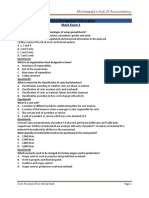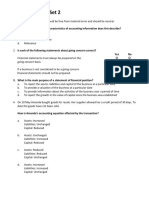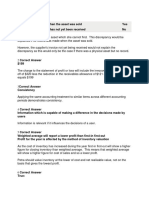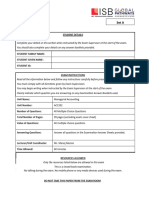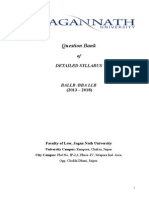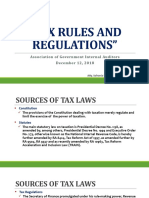Ma2 Mock 3 Dec
Ma2 Mock 3 Dec
Uploaded by
ahmed saeedCopyright:
Available Formats
Ma2 Mock 3 Dec
Ma2 Mock 3 Dec
Uploaded by
ahmed saeedOriginal Description:
Original Title
Copyright
Available Formats
Share this document
Did you find this document useful?
Is this content inappropriate?
Copyright:
Available Formats
Ma2 Mock 3 Dec
Ma2 Mock 3 Dec
Uploaded by
ahmed saeedCopyright:
Available Formats
lOMoARcPSD|25595908
Ma2 Mock 3 - Dec
Audit and Assurance (SKANS School of Accountancy)
Studocu is not sponsored or endorsed by any college or university
Downloaded by ahmed saeed (ahmadsaeedacca@gmail.com)
lOMoARcPSD|25595908
Mirchawala’s Hub of Accountancy
MA2:Managing Costs and Finance:
Mock Exam:3
Question#1:
BBM Co has general overheads of $146,200 for the month of March. It is expected that these will
increase at 2.25% per month until December. Overheads are paid the month after they are incurred.
What is the cash outflow in June for overheads $_______ (to the nearest $)?
Question#2:
Which of the following should be considered when deciding on the most appropriate method of
distributing a report?
(1) Time
(2) Confidentiality
(3) Record keeping
(4) Cost
A. 3 and 4 only
B. 1,2 and 4 only
C. 1 and 2 only
D. 1,2,3 and 4
Question#3:
A manufacturing company makes three products using the same machine for each product. A
budget for the next year has been prepared as follows, on the assumption that production capacity
will be sufficient to meet the known sales demand:
Product A B C
Sales demand (units) 500 400 300
$ $ $
Sales revenue 10,000 20,000 15,000
Variable costs 4,000 15,000 6,000
Fixed costs 4,000 2,000 7,650
Profit 2,000 3,000 1,350
Machine hours per unit 2 5 4
Machine time will be insufficient to meet sales demand in full.
If the company wanted to maximise its annual profit in what order should it prioritise production
and sales of the three products (in descending order of priority)
A. Product C, Product B, Product A
B. Product C, Product A, Product B
C. Product A, Product B, Product C
D. Product B, Product C, Product A
Question#4:
Which of the following is an appropriate cost unit for a coach travel company?
A. Operating cost of a coach station
B. Fuel cost
C. Cost of a coach driver
D. Cost per passenger kilometre
Question#5:
Which of the following is NOT correct regarding methods of business communication?
A. Confidential information should be transmitted by fax
B. Cost may be a consideration when deciding the best communication method
C. Email can be used for external communication
D. Memos perform the same function internally as a letter does externally
From the Desk of Sir Ahmed Shafi Page 1
Downloaded by ahmed saeed (ahmadsaeedacca@gmail.com)
lOMoARcPSD|25595908
Mirchawala’s Hub of Accountancy
Question#6:
Which of the following are reasons for preparing a cash budget?
1. To highlight possible shortages of cash so that necessary steps can be taken to address the
shortage
2. To highlight the possible surplus cash which management could invest in interest-bearing assets
3. To highlight any expected reductions in profit so that management can take action to restore
profits
A. 1,2 and 3
B. 1 and 2 only
C. 1 and 3 only
D. 2 and 3 only
Question#7:
Discounted cash flow analysis is being applied to a project with the following results:
Rate of interest (% per annum) Net present value ($)
13 9,362
19 (2,015)
Using the above results what is the best approximation of the internal rate of return of the
project?
A. 14.1%
B. 13.8%
C. 20.6%
D. 17.9%
Question#8:
What is a by-product?
A. A product that has insignificant saleable value compared with the joint products
B. A product that has no saleable value
C. A product that can be further processed
D. A waste product that has to be disposed of at a cost
Question#9:
Which of the following is the most appropriate basis for apportioning the canteen costs in a
factory?
A. Number of factory employees
B. Indirect labour hours
C. Direct labour hours
D. Direct wages
Question#10:
Which of the following may be used to support claims for overtime payments for salaried staff?
A. Job cards
B. Timesheets
C. Payslips
D. Employee record cards
Question#11:
Which of the following is a calculation of the minimum inventory control level?
A. Re-order quantity plus re-order level minus minimum usage in minimum lead time
B. Re-order level minus maximum usage in maximum lead time
C. Re-order level minus average usage in average lead time
D. Re-order quantity minus maximum usage in maximum lead time
From the Desk of Sir Ahmed Shafi Page 2
Downloaded by ahmed saeed (ahmadsaeedacca@gmail.com)
lOMoARcPSD|25595908
Mirchawala’s Hub of Accountancy
Question#12:
Which of the following are objectives of cash and cheque handling procedures?
1. All monies received are recorded and banked within seven days
2. Payments are properly authorised
3. Cash forecasts are reconciled
4. The duties of receiving and banking are segregated
A. 2 and 3
B. 2 and 4
C. 1,3 and 4
D. 1 and 2
Question#13:
Costs have been recorded at the following three output levels:
Production output 100,000 units 105,000 units 110,000 units
Total costs $207,000 $213,000 $218,200
Using the high-low method what is the variable cost per unit $______ (to two decimal places)?
Question#14:
Is each of the following statements relating to types of cash transaction true or false?
True False
Exceptional items are unusual, for example the cost of closing down part of a business
Revenue items generally relate to the long-term functioning such as raising money from
shareholders, or acquiring non-current assets
Question#15:
Which of the following are justifications for the widespread use of computers in the provision of
management information?
1. Speed of processing
2. Accuracy of processing
3. Volume and complexity of processing requirements
A. 1,2 and 3
B. 1 and 2 only
C. 1 and 3 only
D. 2 and 3 only
Question#16:
The stores ledger control account for a period contained the following summary information:
$’000
Supplier deliveries into stores 321
Indirect materials issued from stores 13
Returns to suppliers 8
Opening inventory in stores 46
Closing inventory in stores 59
There were no inventory discrepancies in the period.
What accounting entry correctly records the issue of direct material from stores?
A. Dr Work in progress account $287,000 Cr Stores ledger account $287,000
B. Dr Stores ledger account $287,000 Cr Work in progress account $287,000
C. Dr Stores ledger account $313,000 Cr Work in progress account $313,000
D. Dr Work in progress account $313,000 Cr Stores ledger account $313,000
From the Desk of Sir Ahmed Shafi Page 3
Downloaded by ahmed saeed (ahmadsaeedacca@gmail.com)
lOMoARcPSD|25595908
Mirchawala’s Hub of Accountancy
Question#17:
The production wages in a company for a period include overtime premium paid to direct
operatives. The company’s policy is to treat overtime premium as a direct cost.
What are the correct bookkeeping entries to account for the overtime premium?
A. Dr Production overheads Cr Wages
B. Dr Work in progress Cr Wages
C. Dr Production overheads Cr Work in progress
D. Dr Work in progress Cr Production overheads
Question#18:
What term is used for the arbitrary sharing of overheads among cost centres?
A. Overhead Absorption
B. Overhead Apportionment
C. Overhead Allocation
D. Overhead Analysis
Question#19:
Which statement is true in reference to the following profit/volume chart?
A. Company A has higher profit than company B
B. Company A has higher fixed cost than company B
C. Company A has a higher contribution to sales ratio than company B
D. Company A has lower break-even sales revenue than company B
Question#20:
A business is considering a project requiring an investment of $200,000 now and with estimated
cash inflow of $23,000 per annum in perpetuity. The first cash inflow of would be received in one
year’s time. The cost of capital is 10% per annum.
What is the net present value of investment?
A. $2,300
B. $30,000
C. $3,000
D. $20,000
Question#21:
There are seven key criteria which guide a bank’s decision about whether or not to lend money to a
customer. These are called the cannons of lending.
Which of the following are included in the cannons of lending?
1. Establishing the margin of profit
2. An assessment of the borrows ability to repay a loan
3. Establishing the purpose of borrowing
A. 1,2 and 3
From the Desk of Sir Ahmed Shafi Page 4
Downloaded by ahmed saeed (ahmadsaeedacca@gmail.com)
lOMoARcPSD|25595908
Mirchawala’s Hub of Accountancy
B. 2 and 3 only
C. 1 and 3 only
D. 1 and 2 only
Question#22:
Which of the following statements concerning feedback control is/are true?
1. Feed forward and feedback control both take place after a variance is reported
2. Feed forward and feedback control are both concerned with uncontrollable variances only
A. Statement 2 only
B. Neither statement
C. Statement 1 only
D. Both statements
Question#23:
In which of the following would service costing be MOST appropriate?
A. Supermarket
B. Hospital
C. Chemical manufacturer
D. Component manufacturer
Question#24:
A company manufactures and sells three products. Product details are as follows:
Product A ($) B ($) C ($)
Contribution per unit 8.00 7.25 8.80
Net profit per unit 2.30 2.40 2.60
Contribution per machine hour 2.50 2.40 2.20
Net profit per machine hour 0.7 0.8 0.65
Machine hours available in the next period will not be sufficient to meet production requirements.
There are no product-specific fixed costs.
What should be the order of priority for production in order to maximise profit?
A. Product A, Product B, Product C
B. Product C, Product A, Product B
C. Product B, Product A, Product C
D. Product C, Product B, Product A
Question#25:
The following is an extract from the list of accounts of a washing machine manufacturer:
Cost codes
Direct material 100 – 1999
Direct labour 2000 – 2999
Direct expenses 3000 – 3999
Production overheads 4000 – 4999
Which two of the following are coded correctly?
A. Code 2160: wages of operatives who work on the product
B. Code 2430:wages of production department supervisor
C. Code 1670: cleaning materials
D. Code 3060: Royalties for component used in the manufacturing product
Question#26
A shop has budgeted to make the following purchases from its suppliers:
Month $
January 90,000
February 82,000
March 96,000
April 88,000
From the Desk of Sir Ahmed Shafi Page 5
Downloaded by ahmed saeed (ahmadsaeedacca@gmail.com)
lOMoARcPSD|25595908
Mirchawala’s Hub of Accountancy
The shop budgets to pay for 75% of purchases in the month of purchase, 20% in the month after
purchase and 5% in the second month after purchase.
What is the shops budgeted payments figure for march $______?
Question#27:
A company which manufactures and sells a single product has the following sales and production
data for a period:
Units
Production 20,100
Sales 18,900
There is no opening inventory.
Profit has been calculated for the period using both absorption costing and marginal costing.
Which absorption profit and marginal profit figures are consistent with the above production and
sales data?
$10,000 $12,000
Marginal profit
Absorption costing
Question#28:
The following data refers to a particular inventory item:
Receipts (units) Issues (units) Total cost ($)
Day 1 200 1,100
Day 3 140
Day 6 150 840
Day 7 140
The weighted average method is used to value inventory issues. A revised weighted average price is
calculated after each purchase.
At what cost per unit (to two decimal places) will the issue on day 7 be made?
A. $5.60
B. $5.57
C. $5.54
D. $5.56
Question#29:
Which of the following is normally treated as a Direct labour cost?
A. Overtime premium due to a temporary backlog in production
B. Overtime premium at the specific request of a customer
C. Uncontrollable idle time
D. Controllable idle time
Question#30:
C CO produces a single product. The budgeted fixed production overheads for the period are
$360,000. The budgeted output for the period is 6,000 units. Opening inventory at the start of the
period consisted of 850 units and closing inventory at the end of the period consisted of 300 units.
The profit for the period under absorption costing was $100,000.
What was the profit for the period using marginal costing principles?
A. $100,550
B. $133,000
C. $99,450
D. $67,000
From the Desk of Sir Ahmed Shafi Page 6
Downloaded by ahmed saeed (ahmadsaeedacca@gmail.com)
lOMoARcPSD|25595908
Mirchawala’s Hub of Accountancy
Question#31:
A company manufactures and sells four products. Details are as follows:
Products
P ($) Q ($) R ($) S ($)
Contribution per unit 16.0 14.5 17.6 19.0
Net profit per unit 4.6 4.8 5.2 5.0
Contribution per machine hour 5.0 4.8 4.4 3.8
Net profit per machine hour 1.4 1.6 1.3 1.0
Machine hours available in the next period will not be sufficient to meet production requirements.
There are no product-specific fixed costs.
What should be the order of priority for production in order to maximise profit?
A. S,R,P,Q
B. R,S,Q,P
C. Q,P,R,S
D. P,Q,R,S
Question#32:
Would job costing be appropriate in each of the following manufacturing environments?
Yes No
Production is carried out in accordance with the special requirements of
Each customer
Products are mass produced for inventory
Question #33:
The management accounts of AB CO show the following expenses for June 20X0:
Cost
($)
New company vehicle 15,000
Painting company logo on vehicle 400
Fuel for company vehicle 300
What is the total capital expenditure for the month $_____?
Question#34:
What is a flexed budget?
A. A budget that is revised to reflect changes as they occur
B. A budget that is changed to reflect the actual level of activity
C. A budget that is adjusted to reflect changing prices
D. A budget that can be used for several purposes
Question#35:
What is an exception report?
A. A report highlighting adverse variances
B. A report highlighting favourable variances
C. A report of variances of a certain magnitude
D. A report prepared as and when required rather than routinely
Question#36:
A company had opening inventories of 17,000 kg and closing inventories of 13,500 kg. Profit for the
period using marginal costing was $124,200.
The fixed overhead absorption rate was $3 per kg.
What was the profit using absorption costing?
A. $134,700
B. $164,700
C. $113,700
D. $83,700
From the Desk of Sir Ahmed Shafi Page 7
Downloaded by ahmed saeed (ahmadsaeedacca@gmail.com)
lOMoARcPSD|25595908
Mirchawala’s Hub of Accountancy
Question#37:
Which of the following correctly describes a sunk cost?
A. A potential cost to spend in the current period
B. A cost which is irrelevant in decision making
C. A cost unaffected by fluctuations in the level of activity
D. A cost which is relevant for decision making
Question#38:
Which of the following is/are likely to be classified as cash for management accounting purposes?
1) Petty cash
2) Bank account balances
3) Marketable securities
A. 1 only
B. 1 and 2 only
C. 1,2 and 3
D. 3 only
Question#39:
Which two of the following may result in fixed overheads being over absorbed?
A. Activity above budget
B. Activity below budget
C. Expenditure above budget
D. Expenditure below budget
Question#40:
Z CO makes a single product and incurs fixed costs of $9,000 per month. The variable cost per unit is
$3.00 and each unit sells for $7.00. Monthly sales demand is 8,000 units.
What is the break-even point in monthly sales unit_____?
Question#41:
Manufacturing process costs total 179,070 for a period. 9,000 kg of raw materials were processed
with the following result:
KG
Completed good output 8,100
Normal loss 1,200
Abnormal gain 300
What was the cost per kg _____ (to two decimal places)?
Question#42:
Is each of the following statements relating to process costing true or false?
True False
Abnormal gains are debited to the process account at the cost per unit
incurred on normal production
Normal losses are credited to the process account at the cost per unit
incurred on normal production
Question#43:
Is each of the following statements, about cash management in the public sector, true or false?
True false
Legislation requires public sector organizations to earn a minimum
rate of interest on all investments.
Public sector organizations are free to invest surplus fund in any
investment.
Question#44:
Which of the following correctly describes the concept of leading and lagging?
A. Raising share capital to improve cash flow
From the Desk of Sir Ahmed Shafi Page 8
Downloaded by ahmed saeed (ahmadsaeedacca@gmail.com)
lOMoARcPSD|25595908
Mirchawala’s Hub of Accountancy
B. Shortening the working capital cycle to obtain money from customers as soon as possible, and
taking as much credit from suppliers as possible
C. Revising cash forecasts on a periodic basis
D. Increasing the working capital cycle by increasing customer credit and paying suppliers as soon
as possible
Question#45:
An accountancy practice had an overhead budget of $21,060 for a period. Actual overhead
expenditure in the period was $21,720. Overheads are absorbed on the basis of client hours worked
which totalled 2,375 in the period and resulted in under absorption of $345.
What was the budgeted overhead absorption rate per client hour$_____?
Question#46:
5,400 units of a company’s single product were sold for total revenue of $140,400. Fixed costs in the
period were $39,420 and net profit was $11,880.
What was the contribution per unit $______ (to two decimal places)?
Question#47:
You have been asked by the finance manager to store the monthly management accounts until the
senior management meeting. The information is confidential and only selected individuals are
allowed to see it.
Which of the following is the most appropriate method of storing the information?
A. Post a softcopy to the public area of the company’s website
B. Print a hardcopy and leave it on your desk
C. Leave a hard copy in a drawer by your desk that cannot be locked
D. Save a softcopy on the company’s computer system in accordance with company IT policy and
protect the file with a password
Question#48:
A company is in the process of bringing a new product to market and has incurred development costs
of $35,000 to date. Further costs of $28,000 will be required to complete the development of the
product.
Marketing spend for the last six months was $16,000 and it is expected that expenses in this area will
be $22,000 for the next six month period.
In deciding whether to continue with the development and marketing of new product, what is the
relevant cost $______?
Question#49:
Assuming that the investment is not held until maturity, and there is no inflation, which of the
following have a risk of fluctuation in the capital value?
1) Certificate of deposit
2) Government stock
3) Bank deposit
A. 1 and 2
B. 1 and 3
C. 2 and 3
D. 1 only
Question#50:
Which of the following could cause an adverse labour efficiency variance?
A. Use of a higher grade of labour
B. Purchase of higher priced materials of standard quality
C. Use of untrained labour
D. Most efficient use of materials
From the Desk of Sir Ahmed Shafi Page 9
Downloaded by ahmed saeed (ahmadsaeedacca@gmail.com)
lOMoARcPSD|25595908
Mirchawala’s Hub of Accountancy
From the Desk of Sir Ahmed Shafi Page 10
Downloaded by ahmed saeed (ahmadsaeedacca@gmail.com)
You might also like
- Ma2 Mock 1Document11 pagesMa2 Mock 1sameerjameel678No ratings yet
- Ma2 Mock Exam 3 AnswersDocument12 pagesMa2 Mock Exam 3 Answerssameerjameel678100% (2)
- MA2 Mock 2-As - 2023-24Document8 pagesMA2 Mock 2-As - 2023-24daniel.maina2005100% (1)
- Ma2 Mock ExamDocument13 pagesMa2 Mock Examsaad shahid100% (1)
- Fa2 Mock Exam 2Document10 pagesFa2 Mock Exam 2Iqra Hafeez100% (1)
- Acc 100 Quiz AnswersDocument9 pagesAcc 100 Quiz Answersscribdpdfs100% (1)
- FA October 16Document37 pagesFA October 16AngelaNo ratings yet
- Examiner's Report - FA2 PDFDocument40 pagesExaminer's Report - FA2 PDFSuy YanghearNo ratings yet
- MA2 SummaryDocument20 pagesMA2 SummarypringuserNo ratings yet
- Ma2 Specimen j14Document16 pagesMa2 Specimen j14talha100% (4)
- FIA MA1 Course Exam MOCK 3 QuestionsDocument12 pagesFIA MA1 Course Exam MOCK 3 QuestionsBharat Kabariya67% (3)
- FXTM - Model Question PaperDocument36 pagesFXTM - Model Question PaperRajiv Warrier0% (1)
- Final Thesis Research Center PDFDocument74 pagesFinal Thesis Research Center PDFJunell Erika Dela CruzNo ratings yet
- Class Action Lawsuit Against Overstock - Com, As Amended 3-13-20Document90 pagesClass Action Lawsuit Against Overstock - Com, As Amended 3-13-20garyrweissNo ratings yet
- Ma2 Mock 2Document10 pagesMa2 Mock 2yashwant ashokNo ratings yet
- MA1 Mock Exam 2Document11 pagesMA1 Mock Exam 2138.Mehreen “79” Faisal100% (1)
- MA1 Mock Exam 1Document11 pagesMA1 Mock Exam 1138.Mehreen “79” Faisal50% (2)
- Ma2 Mock 3Document10 pagesMa2 Mock 3yashwant ashokNo ratings yet
- FIA - MA2 - Final Mock Exam - Qs - 2023Document18 pagesFIA - MA2 - Final Mock Exam - Qs - 2023cnarin100% (2)
- Fa2 DepreciationDocument4 pagesFa2 Depreciationamna zaman100% (1)
- Fa2 Mock 3 AnswersDocument13 pagesFa2 Mock 3 Answerssameerjameel678No ratings yet
- 02 MA2 LRP QuestionsDocument36 pages02 MA2 LRP QuestionsKopanang Leokana67% (3)
- Fa2 Inventory Valuation TestDocument4 pagesFa2 Inventory Valuation Testamna zaman100% (2)
- Fa2 Mock Test 2Document7 pagesFa2 Mock Test 2Sayed Zain Shah100% (1)
- Ma2 Mock 2Document10 pagesMa2 Mock 2shakeebkhan095100% (1)
- MA1 (Mock 2)Document19 pagesMA1 (Mock 2)Shamas 786No ratings yet
- Mock 2Document13 pagesMock 2Angie Nguyen50% (2)
- Ma2 Exam ReportDocument3 pagesMa2 Exam ReportAhmad Hafid Hanifah100% (1)
- FA2 Accruals and PrepaymentsDocument4 pagesFA2 Accruals and Prepaymentsamna zaman100% (2)
- Fa2 Mock 2 Question - 1Document18 pagesFa2 Mock 2 Question - 1sameerjameel678No ratings yet
- Fa2 Mock 2 AnswersDocument14 pagesFa2 Mock 2 Answerssameerjameel678No ratings yet
- Fa2 Mock 1 Question-1Document19 pagesFa2 Mock 1 Question-1sameerjameel678No ratings yet
- MA1 First TestDocument14 pagesMA1 First TestMishael MAKE-UP100% (1)
- Fa1 Mock 2Document9 pagesFa1 Mock 2smartlearning1977No ratings yet
- Fa2 Mock Exam 2 AnswersDocument12 pagesFa2 Mock Exam 2 AnswersIqra Hafeez0% (1)
- Skans School of Accoutancy Subject Ma1 Test Teacher Shahab Name Batch Obtained Marks Total Marks 30Document4 pagesSkans School of Accoutancy Subject Ma1 Test Teacher Shahab Name Batch Obtained Marks Total Marks 30shahabNo ratings yet
- FA 2 Practice Test Set 2Document12 pagesFA 2 Practice Test Set 2Chhour Thalika100% (1)
- Ma1 Mock Exam 1 AnswersDocument18 pagesMa1 Mock Exam 1 Answers138.Mehreen “79” FaisalNo ratings yet
- Practice Qs Chap 13HDocument4 pagesPractice Qs Chap 13HSuy YanghearNo ratings yet
- Test 1 Ma2Document15 pagesTest 1 Ma2Waseem Ahmad Qurashi67% (9)
- MA 1 Mock Exam QuestionDocument4 pagesMA 1 Mock Exam QuestionAbdul Gaffar100% (1)
- FA2 Mock 3 ExamDocument12 pagesFA2 Mock 3 ExamRameen Ch100% (4)
- FA1 Mock 1Document10 pagesFA1 Mock 1Abdul MughalNo ratings yet
- FIA MA1 Mock Exam - QuestionsDocument20 pagesFIA MA1 Mock Exam - QuestionsSim LeeWen50% (2)
- Fa2 Mock 1 AnswersDocument12 pagesFa2 Mock 1 Answerssameerjameel6780% (1)
- Ma2 Mock Exam 3 AnswersDocument12 pagesMa2 Mock Exam 3 Answersyashwant ashokNo ratings yet
- Absorption and Margin CostingDocument8 pagesAbsorption and Margin CostingIshfaq AhmadNo ratings yet
- Cost Classification MA1 Test 1Document4 pagesCost Classification MA1 Test 1Tallal Tariq0% (1)
- FA2 Mock Exam 2 (Tutorial-8)Document10 pagesFA2 Mock Exam 2 (Tutorial-8)Chit SnowNo ratings yet
- FA Consolidation Test - Questions S20-A21 PDFDocument16 pagesFA Consolidation Test - Questions S20-A21 PDFAlpha MpofuNo ratings yet
- FA 2 Practice Test Set 1Document14 pagesFA 2 Practice Test Set 1Chhour ThalikaNo ratings yet
- Chapter 6 Bank Recon Practice QHDocument3 pagesChapter 6 Bank Recon Practice QHSuy Yanghear100% (1)
- FA1 MOCK EXAM CHAPTER 1 To 5Document6 pagesFA1 MOCK EXAM CHAPTER 1 To 5Haris AhnedNo ratings yet
- FA2 Mock Exam 1Document10 pagesFA2 Mock Exam 1smartlearning1977No ratings yet
- Fa1 PilotDocument14 pagesFa1 PilotMuhammad Yousuf100% (3)
- Chapter 6 Suspense Practice Q HDocument5 pagesChapter 6 Suspense Practice Q HSuy YanghearNo ratings yet
- MA2 Mock 3Document10 pagesMA2 Mock 3sameerjameel678No ratings yet
- F2 Mha Mock 3Document12 pagesF2 Mha Mock 3Annas SaeedNo ratings yet
- Accounting TestDocument15 pagesAccounting TestBenson WencenslausNo ratings yet
- CPA BEC Mock QuestionsDocument21 pagesCPA BEC Mock Questionsharish100% (1)
- 2017 ACM s1 ADEL Final ExamDocument19 pages2017 ACM s1 ADEL Final ExamAlistairNo ratings yet
- Midterm Set ADocument9 pagesMidterm Set Afiseco4756No ratings yet
- Kuwait TINDocument2 pagesKuwait TINAtif YadavNo ratings yet
- Financial, Treasury and Forex ManagementDocument542 pagesFinancial, Treasury and Forex ManagementPraveen100% (1)
- IrlwDocument203 pagesIrlwShriHemaRajaNo ratings yet
- Aramit Cement Limited: Rights Share Offer DocumentDocument70 pagesAramit Cement Limited: Rights Share Offer DocumentSayeedMdAzaharulIslamNo ratings yet
- Balance Sheet and Statement of Cash Flows: Intermediate Accounting 12th Edition Kieso, Weygandt, and WarfieldDocument46 pagesBalance Sheet and Statement of Cash Flows: Intermediate Accounting 12th Edition Kieso, Weygandt, and WarfieldGisilowati Dian PurnamaNo ratings yet
- Accounting DictionaryDocument11 pagesAccounting DictionaryKhan Mohammad100% (1)
- Valuation AssignmentDocument20 pagesValuation AssignmentHw SolutionNo ratings yet
- Open Sky Di IndiaDocument8 pagesOpen Sky Di IndiaDila NoorNo ratings yet
- ECO401 All Past Solved Mid Term Papers of ECO401 By: Midterm Examination Spring 2009 ECO401-Economics (Session - 2)Document43 pagesECO401 All Past Solved Mid Term Papers of ECO401 By: Midterm Examination Spring 2009 ECO401-Economics (Session - 2)Muhammad TariqNo ratings yet
- Economics: Lec-1 Prof. Ravikesh SrivastavaDocument18 pagesEconomics: Lec-1 Prof. Ravikesh SrivastavasrimaNo ratings yet
- Part 1 - Tax Rules & RegulationsDocument223 pagesPart 1 - Tax Rules & RegulationsBien Bowie A. CortezNo ratings yet
- Assignment-KMBN FM02-III-Shaleen Suneja-2022-23Document2 pagesAssignment-KMBN FM02-III-Shaleen Suneja-2022-23Vivek SharmaNo ratings yet
- Vishal Khandelwal Investor Interview SeriesDocument177 pagesVishal Khandelwal Investor Interview SerieshamsNo ratings yet
- Start A BusinessDocument117 pagesStart A Businessmuntopia100% (5)
- 2nd Year QuestionnairesDocument7 pages2nd Year QuestionnaireswivadaNo ratings yet
- Final Exam - Inter 1 (Batch 2022) - RevDocument14 pagesFinal Exam - Inter 1 (Batch 2022) - RevVanessa vnssNo ratings yet
- 61Fin2Fim - Financial Management Tutorial 9 - Capital BudgetingDocument7 pages61Fin2Fim - Financial Management Tutorial 9 - Capital BudgetingThuỳ PhạmNo ratings yet
- Bajaj Electricals LimitedDocument72 pagesBajaj Electricals Limitedkrsandy073No ratings yet
- NPA Management, Canara BankDocument36 pagesNPA Management, Canara BankShashank Madimane0% (1)
- Oxford ModelDocument29 pagesOxford ModelasdfagNo ratings yet
- Starbucks Swot AnalysisDocument3 pagesStarbucks Swot Analysisyounelba100% (1)
- CHP 5Document5 pagesCHP 5Adeeb Hassannoor0% (1)
- Managerial Remuneration Checklist FinalDocument4 pagesManagerial Remuneration Checklist FinaldhuvadpratikNo ratings yet
- Cost of QualityDocument14 pagesCost of QualitySreenath HtaneersNo ratings yet
- SPE-ESCO Financial Model Tool v3.3Document21 pagesSPE-ESCO Financial Model Tool v3.3santhi0% (1)
- Ansay, Allyson Charissa T. - BSA 2 - Job Order CostingDocument9 pagesAnsay, Allyson Charissa T. - BSA 2 - Job Order Costingカイ みゆきNo ratings yet
- JK Accounts ResearchDocument7 pagesJK Accounts ResearchkrunalNo ratings yet
- Demirew Getachew - Tax Reform in Eth and Progress To DateDocument23 pagesDemirew Getachew - Tax Reform in Eth and Progress To Datewondimg100% (5)
















